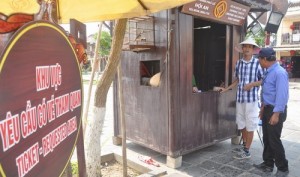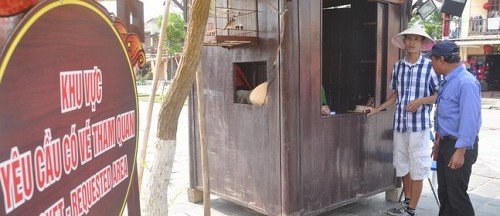Visitors to Hoi An are charged with a ticket entry in order to raise funds for its preservation, but the rude way that the new rule is being imposed is what tourists have been protesting about.

Photo by http://tuoitrenews.vn/lifestyle/19200/foreigners-outraged-by-6-entrance-fee-to-vietnams-hoi-an-old-town
Hoi An has been recognized as a world heritage site by UNESCO since 1999. Located in the coastal province of Quang Nam, the town is rich in heritage, both local and foreign. This is evident in its blend of cultural influences such as colorful lanterns, craft villages, pristine beaches, river cruises, and delectable food. The town is also a haven of ancient houses which the local residents actually still live in, but are in dire need of restoration for fear of collapse, even total destruction.
Since 1995, tourists who visit Hoi An have been required to pay an entrance ticket worth VND120,000 (US$6) for foreigners and VND80,000 for Vietnamese. One ticket entitles a visitor to go around the town of Hoi An. A foreigner is allowed to visit five to six tourist spots while local visitors, three to four. According to the Hoi An People’s Committee, the admission fee has been calculated based on a finance ministry directive. The following rates have been the same since 2012.
Ticket booths used to be few and found only in certain parts of the area, but lately have been put up at every entrance of the town. This has been justified by the local authorities as ensuring a fair competition between the tour companies since some pay for their clients’ tickets while some fail to do so, and visitors end up touring the place without discovering the historical remnants, complaining that Hoi An has nothing valuable to offer. Eighty five percent of the revenue of the entrance fees collected will be used to repair the historical relics of Hoi An. But of the estimated two million tourists who visit Hoi An every year, only about 30% are reported to buy the tickets, depriving the town of dozens of billions of dong which could have been used to restore the relics.
Some travel companies in fact agree with the entrance fees, stating that the money is needed to restore important structures in Hoi An such as historic houses, assembly halls and museums. They believe that the amount is reasonable and the only problem is with the way it is implemented. Misunderstanding also comes in as to when the fee should be charged. The entrance fee should only be charged to visitors on a tour to Hoi An and not to people simply walking down the street or wanting to go to a restaurant to eat, to a bar to drink, and other establishments for whatever reason.
The presence of uniformed security guards at the entrance of the town is also said to make the place look and feel more like a prison camp than a heritage site, making visitors uncomfortable. Even local residents are starting to get annoyed with the situation because they themselves are being charged for entering the town even for the purpose of going home. It should be noted that Hoi An is home to both Vietnamese and foreigners.
Collecting entrance fees is in fact against the general rules in other countries such as Cambodia and Thailand which have been successful in their tourism efforts without charging such payments. Tickets can be sold to visit a relic, a sightseeing spot or other specific places, but not to enter a town. Certain suggestions have come up for Hoi An to raise the money needed for the improvements. One is an indirect taxing system, levying hotels or tour operator charges instead of asking for a direct entrance fee. Transparency and accountability are also being demanded, showing how or where each dollar is spent to prove that the money was indeed used for restoration purposes.
In defense of the blue-shirted security guards though, their lack of good English skills is seen as the major cause of misunderstanding between the tourists, thereby assigning those who are proficient with the language to be the one to explain the ticket policy to visitors. A high-ranking official of the town party committee has been notified of the issue and has vowed to correct the manner in which security guards at the area collect the payment, reported to harass and even chase tourists down the street for the fee. The local chief has promised to discuss the matter with other authorities and inform the media soon of the measures agreed upon.
In 2013, alone, about 1.2 million tourists visited Hoi An. An estimated VND80 billion was collected from the entrance tickets. Millions of tourists visit Hoi An all the time and spend a lot of money visiting the town’s historical remnants and even modern establishments like hotels, restaurants and bars. Insisting on this rule may in fact discourage tourists from visiting Hoi An in the future and disgrace the town altogether. May the local government seriously consider Hoi An’s long-term welfare and not simply short-term goals, if not gratification.
